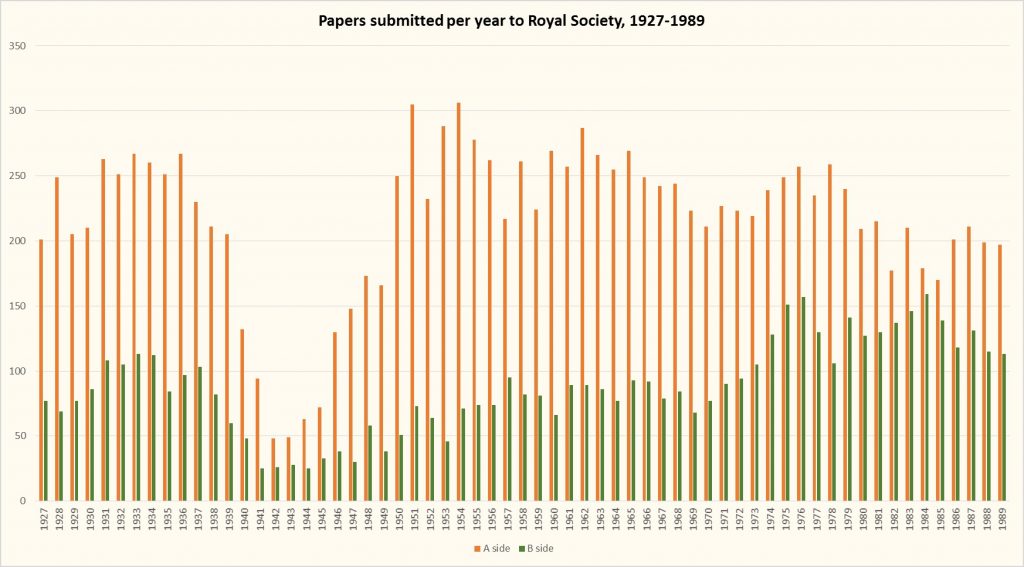
This graph shows the number of papers submitted to the Royal Society over the course of (roughly) the twentieth century. It includes papers that would ultimately be published in both Transactions and Proceedings, as well as papers that were never published.
Throughout the period from 1927 to 1989, the Society was receiving more submissions from the physical sciences (series A) than from the life sciences (series B). But by the 1970s, the gap was closing (and now, in the early twenty-first century, biological science submissions outweigh those from the physical sciences).
The effect of the Second World War is quite clear.
It is also clear that, although analyses of Web of Science and similar databases suggest that the number of scientific papers published in the world was increasing throughout the twentieth century (and even more rapidly after the war), this expansion was not happening at the Royal Society. (Most likely, it was taking place in the many new journals being created in the 1950s and 1960s.)
The dominance of the physical sciences at the Royal Society is a legacy of the late nineteenth century, when many of the most prominent figures in the Royal Society’s administration were physical scientists (e.g. George Gabriel Stokes, secretary and later president; Lord Rayleigh; William Thomson Lord Kelvin).
Unlike other scientific disciplines, physicists did not have a specialist learned society of their own until 1873 (when the Physical Society was formed). Thus, while geologists, astronomers, botanists, zoologists and chemists had alternative places to meet and to publish, physicists continued to focus on the Royal Society. They were heavily involved in running it, and published lots of papers with it.
The Society was aware of the relative lack of papers being submitted from the biological sciences from at least the early twentieth century. From the 1950s, there were concerted efforts to recruit more papers from the life sciences, and fellows were urged to help. The upwards trend of this graph from the 1970s suggests that it may finally have been working.
Where do the data come from?
From the 1850s until the 1980s, all papers submitted to the Society (regardless of which journal they were intended for) were recorded in a series of ledgers known as the ‘Register of Papers’. From 1927, those ledgers were kept in two series, A=physical sciences; B=biological sciences, reflecting the two series of Transactions (split in 1887) and of Proceedings (splitin 1905).
From 1927, the editorial staff responsible for maintaining the ‘Register of Papers’ recorded the number of submissions per month in a table inside the front cover, along with running totals. So, from this point onwards, it is relatively easy to compare the number of submissions coming from the life sciences and the physical sciences.

3 Replies to “Submissions in life sciences vs physical sciences, 1927-1989”